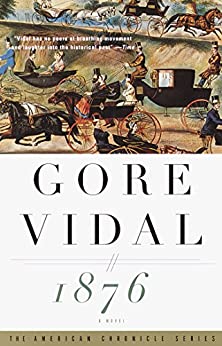When I was selecting a book to read for the 1976 Club, I realized I had read only one book by Gore Vidal and that so long ago I could barely remember it. So, I picked 1876.
Vidal’s sometime-narrator Charles Schuyler is returning to America after almost a lifetime in Europe, where he was documenting European events for the American press. He is accompanied by his daughter Emma, the widowed Princess d’Agrigente. Their circumstances are dire. Schuyler’s fortune was wiped out in the Panic of ’73, and when d’Agrigento died unexpectedly, Schuyler was shocked to find that the Prince’s debts exceeded his fortune. So, Schuyler has come back to America with two goals—to help get Governor Tilden elected as President in the next election so that he will be granted a post and to find a wealthy husband for his daughter.
They first return to New York. It is the Gilded Age, and they are at once drawn into the opulent but vulgar world of robber barons, the Astors and others, who now that they are loaded are trying to become the heads of society. Vidal uses this section to draw sketches and repeat gossip about many of these figures. The first section of the novel reminded me very much of Edith Wharton’s The Age of Innocence. I recognized some characters, although here they go by their real names.
I was about 100 pages into this social whirl, observed with a great deal of snark, when I began to wonder where the plot of the novel was. It eventually emerged, with almost creaking slowness, as the events of the election of 1876, told with a great deal of bias.
Now, I’m not an expert on this period, but I recently read Ron Chernow’s biography of President Grant. In it, he made the point that Grant’s ruined reputation was partially a result of the number of Southern historians who predominated from the post-Civil War years up well past World War II. Well, Vidal has certainly read them, for he does his best to continue trashing Grant. Governor Tilden is running as a Democrat, but not once do his characters mention, for example, the dire results for the South if a Democrat was elected that year. At this time, Federal troops were still posted in the South because people—particularly black men—were still being murdered years after the war. Vidal glancingly mentions but shrugs off suggestions that people were being “discouraged” from voting Republican and says that Grant dispatched troops to some Southern cities to meddle with the vote. Grant sent troops to avoid more deaths and to allow people to vote the way they wanted to. In any case, the result of the election for the South was the same, because the Republican candidate, Rutherford Hayes, promised the removal of troops from the South to get more votes, thus ending Reconstruction and setting the South back years in its recovery and in civil rights.
The 1876 election was stolen from Tilden, and the story of it might have been interesting if more impartially handled. Instead, Vidal makes Tilden the only honest politician in a country riddled with corruption (it was, but I doubt Tilden was the only honest man) and plays down the skullduggery engaged in by the Democrats.
Further, there are too many characters in this novel to keep track of and they are too lightly characterized. Vidal seems more interested in relating scandalous tidbits and making up epigrams.
Then there’s the description on the novel cover, which should have tipped me off about how I was going to feel about it. I know that authors don’t write the blurbs, but it’s he that calls his historical novels “Narratives of Empire.” Now there’s a guy who takes himself seriously. The cover says, “With their broad canvas and large cast of fictional and historical characters, the novels in this series present a panorama of the American political and imperial experience as interpreted by one of its most worldy, knowing, and ironic observers.” Oh, man.
Related Posts
The Fall of the House of Walworth: A Tale of Madness and Murder in Gilded Age America





